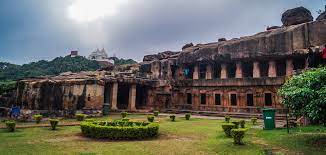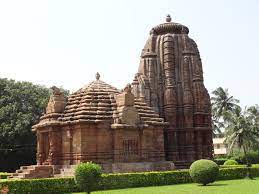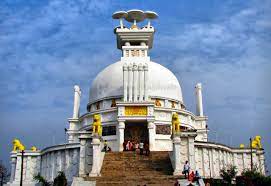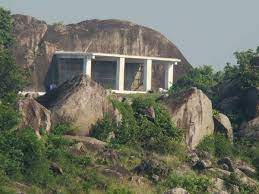
Archaeological sites in odisha
Sun Temple, Konarak
Built in the thirteenth century, it was conceived as a gigantic solar chariot with twelve pairs of exquisitely-ornamented wheels dragged by seven rearing horses. The temple comprised a sanctum with a lofty (presumably over 68 m. high) sikhara, a jagamohana (30. m. square and 30. m. high) and a detached nata-mandira (hall of dance) in the same axis, besides numerous subsidiary shrines. The sanctum and the nata-mandira have lost their roof. The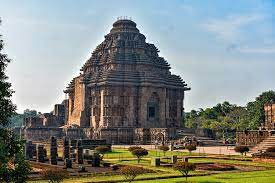
Udaigiri & Khandagiri Caves, Bhubaneswar
The twin hills Udayagiri and Khandagiri (Lat. 20.16 N; Long. 85.47E) are located in the vicinity of Bhubaneswar town. The National Highway No.5 passes through the close proximity of the hills. These two hills represent one of the earliest groups of Jaina rock-cut architecture in eastern India in the field of architecture, art and religion. These caves were first brought to the notice by A. Stirling in 1825 A.D.
Rising abruptly amidst a wide expanse of arid lateritic soil both the hills separated from each other by a narrow row through which passes modern road between Bhubaneswar and Chandaka. The ancient names of the twin hills of Udayagiri and Khandagiri are Kumari and Kumara parvatas respectively. . There are total 33 rock cut caves on both the hills out of which 18 caves are excavated on Udayagiri hill while 15 are on the Khandagiri hill. Generally caves are single storied but a few of them are double storied also.
These hills are honeycombed with excavated rock-cut caves, essentially meant for the dwelling retreats of the Jaina recluses. On the basis of inscriptional evidences, these caves were first excavated by king Kharavela of Chedi dynasty and his successors who were devout Jainas during the first century B.C. The Jaina occupation was continued here with occasional breaks down to the present day. The Jain temple on the top of the Khandagiri hill was constructed in late 19th century is under worship even at present, preserving the continuity and tradition of the glorious past of the hill.
Rajarani Temple, Bhubaneswar
The Rajarani temple, Bhubaneswar in the district of Khurda is located towards north-east of Lingaraj temple is one of the most beautiful temples representing a unique experiment in the field of architecture in Orissa. The temple, in all probability, referred to in the traditional sanskrit texts as Indresvara Siva temple is remarkable for its sculptural excellence, profusion of ornaments, exuberant architectural features and multiple scroll work. At present, the sanctum is devoid of any deity. The present name Rajarani has been derived from a very fine grained yellowish sand stone called Rajarania in common parlance with which the entire edifice has been built. Mellowed by time, the glaring amber of the stone complements its architectural splendor.
The temple has panchanga bada or five divisions viz., pabhaga, talajangha, bandhana, uparajangha and baranda. The lowermost division is called pabhaga having five decorative mouldings namely, khura, kumbha, patta, kani and basanta. The superstructure (gandi) of the temple is distinguished by number of miniature turrets (angasikharas). The composite form of the temple with clustering of such miniature turrets, multiple recesses and angles make the edifice circular in appearance. Above the superstructure is crowned with a fluted disc shaped architectural members called amalaka. A vase (kalasa) surmounts the amalaka as the crowning finial.
Excavated Buddhist site, Laitagiri
Lalitgiri, locally known as Naltigiri in Birupa-Chitrotpala valley is one among the major centers of Buddhism in the Mahanga Tahsil of Cuttack district. It is 90 km. away from the state capital, Bhubaneswar. The site is couched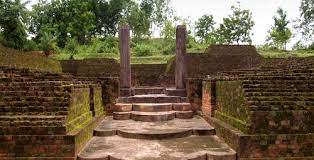
Dhauli, Odisha
Dhauli hills are located on the banks of the river Daya, 8 km south of Bhubaneswar in Odisha (India). It is a hill with vast open space adjoining it, and has major Edicts of Ashoka engraved on a mass of rock, by the side of the road leading to the summit of the hill.
Dhauli hill is presumed to be the area where the Kalinga War was fought. The Rock Edicts found here include Nos. I-X, XIV and two separate Kalinga Edicts.In Kalinga Edict VI, he expresses his concern for the “welfare of the whole world”. The rock-cut elephant above the Edicts is the earliest Buddhist sculpture of Odisha. The stone elephant shows the animal’s foreparts only, though it has a fine sense of form and movement.
Jaugada,odisha
Jaugada ruined fortress in the Ganjam district in Odisha, India. Jaugada lies 35 km north-west of Berhampur and 160 km south-west of Bhubaneshwar. Once a provincial Mauryan fortified capital of the newly conquered province of Kalinga, Jaugada is famed by its version of the monumental stone-cut edicts in Prakrit of the Mauryan emperor Ashoka.
Despite J.D. Beglar’s description during the later 19th century of the extant fortification towers and moat (“The walls had towers, also of earth, at each of the four corners, and also on each flank of each of the eight entrances”), without photos and drawings, the remains are difficult to visualize and comprehend. In 1956 Debala Mitra of the Archaeological Survey of India transected the northern glacis with a trench. The now collapsed trench of this investigation appears to lie just east of the eastern gate of the north wall. It is near the great Shiva temple Kaleswar & Rameswar (which is known as a temple where Shiva and Vishnu are seen together).
OPSC Notes brings Prelims and Mains programs for OPSC Prelims and OPSC Mains Exam preparation. Various Programs initiated by OPSC Notes are as follows:-- OPSC Mains Tests and Notes Program
- OPSC Prelims Exam 2020- Test Series and Notes Program
- OPSC Prelims and Mains Tests Series and Notes Program
- OPSC Detailed Complete Prelims Notes
